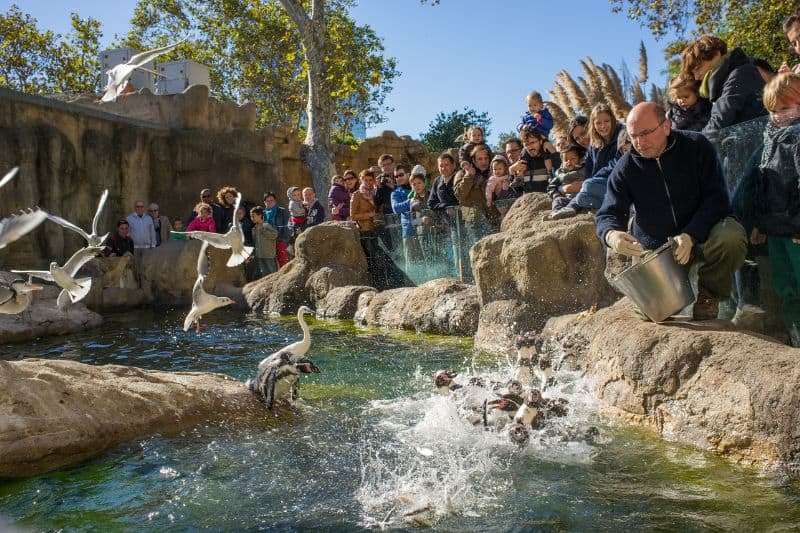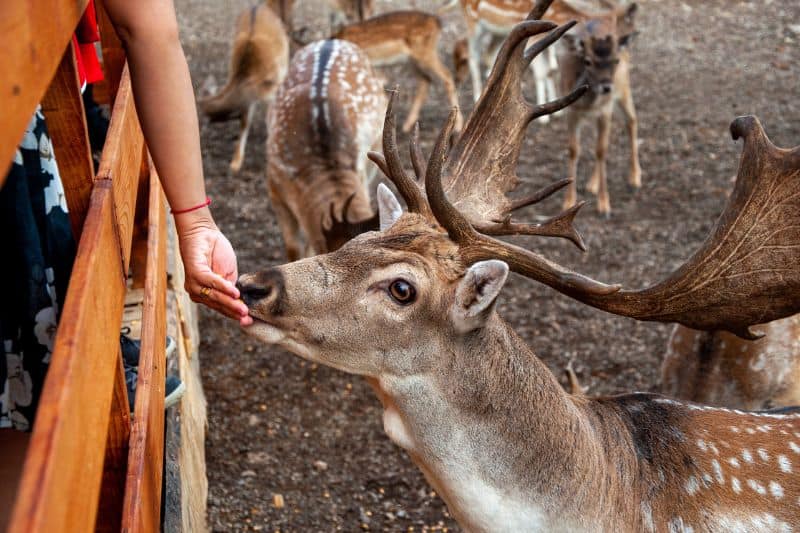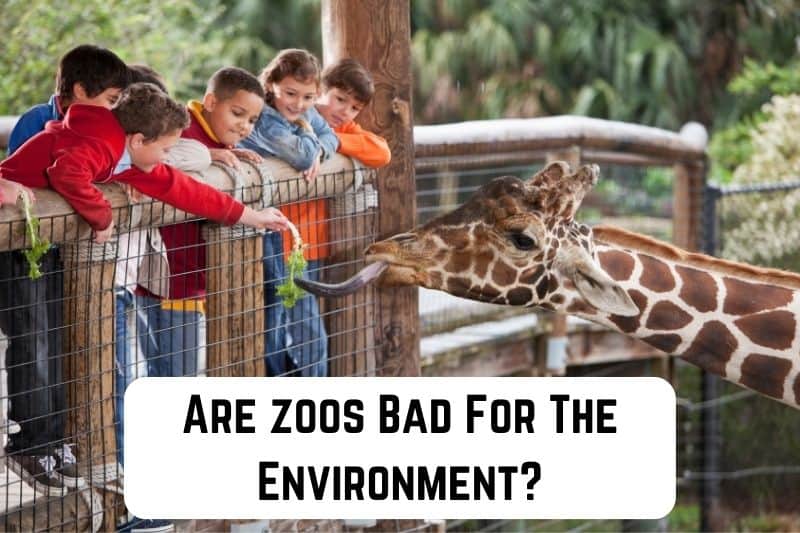Let’s face it: Who on earth doesn’t enjoy a trip to the zoo? It’s a favorite pastime for many, offering an array of captivating sights, from the magnificent train of the peacock to the enigmatic rattle of the rattlesnake’s tail.
Yet, amid all this excitement and wonder, one crucial question lingers: Are zoos bad for the environment?
Well, if that’s the same question you’re asking, this article is just for you. Herein, we’ll delve into the ways in which zoos impact the environment and discuss potential solutions to mitigate any adverse effects. Let’s embark on this journey and uncover the truth about zoos and their environmental impact.
Read: Environmental Impact of Fireworks (And Alternatives)
Are Zoos Good or Bad for the Environment?
Zoos are generally not good for the environment. Establishing zoos requires a lot of modification, which may mean damaging natural habitats for some animal species. Zoos also involve distant movement of wildlife, releasing more greenhouse gasses into the environment, consequently contributing to global warming impact.
In fact, the environment isn’t the only thing negatively affected by zoos. The animals, too, are also affected.
Zoos mean that animals have to live in captivity, forever forfeiting the freedom they’d otherwise get in their natural habitat. This affects their physical and mental health and introduces an imbalance in the ecosystem that may take forever to readjust.
A study looked at over 4500 elephants and found that the ones in European zoos only lived for about 17 years, while those in Amboseli National Park lived for about 56 years. That’s less than a third of their normal lifespan.
So, as much as zoos are surefire ways of creating memories, laughter, and moments of excitement with your loved ones, they’re not best friends with the environment and can also negatively affect some animal species.
Let’s dig deep and examine some of the negative impacts of zoos on the environment.
Environmental Impacts of Zoos
Zoos, while often seen as places of wonder and education, can have significant environmental impacts as already established. These impacts range from habitat destruction to resource consumption, waste management issues, and so much more.
Understanding these effects is crucial in assessing the overall sustainability of zoos.
Habitat Destruction
One of the most pressing concerns associated with zoos is habitat destruction. Constructing and expanding zoological facilities often involves clearing vast areas of land, leading to the destruction of natural habitats.
This displacement of native flora and fauna not only disrupts ecosystems but also diminishes overall biodiversity.
For instance, the development of the Shanghai Wild Animal Park in China resulted in the loss of local forests and wetlands, displacing numerous species from their natural habitats.
Such habitat loss can have profound and enduring effects on wildlife populations, alter ecosystem dynamics, and contribute to the fragmentation of habitats. In some cases, they can even cause extinction of some flora and fauna.
2. Zoos Have Heavy Resource Consumption
Zoos are intensive consumers of resources, requiring substantial amounts of water, electricity, and food to sustain their operations. The scale of activities, from maintaining animal enclosures to catering to visitor needs, contributes to high resource demands.
This extensive resource consumption can strain local ecosystems, exacerbate water scarcity and food shortage issues, and contribute to environmental degradation.
Additionally, the energy consumption of zoos, necessary for heating and cooling animal enclosures, lighting, and other facilities, further adds to their ecological footprint.
3. Waste Management Issues
The management of waste generated by zoos poses significant challenges. With thousands of visitors and numerous animal enclosures, zoos produce substantial amounts of waste daily.
You see, not all visitors grasp the significance of preserving a clean and healthy environment. Some individuals thoughtlessly discard plastic water bottles, plastic food wrappers, and various forms of litter in areas not designated for waste disposal.
Such actions create a visual nuisance and pose a grave threat to wildlife. Certain species may mistake the litter, particularly plastic wrappers, for food. Ingesting this litter can result in illness and, in severe cases, lead to fatal complications, endangering the lives of these animals.

4. Impact on Local Ecosystems
The presence of zoos can also impact local ecosystems beyond their boundaries. For example, escaped animals from zoos can disrupt local wildlife populations and ecosystems.
In some cases, the stray animals can injure or even kill the locals or their livestock. A case in point is what happened at the Kenyan Nairobi National Park in 2016. A lion escaped from Kenya’s capital national park and attacked a man. While the man didn’t die, he was so seriously injured that he had to be hospitalized for days.
In a different instance, 5 stray leopards killed over 50 goats and sheep in Kajiado, Kenya, leaving the affected family suffering a significant amount of loss.
The Kenya Wildlife Service (KWS) took a long time to respond to the emergency because they were occupied with another similar mission — driving elephants away from farms in the same area. This highlights the severity of the situation and the challenges faced in managing such crises.
5. Carbon Footprint
Zoos contribute to greenhouse gas emissions through various activities. Firstly, their construction and maintenance entail considerable energy consumption, including electricity for lighting, heating, and cooling, as well as fuel for transportation and machinery.
Additionally, procuring food for animals often involves long-distance transportation, refrigeration, and packaging, all of which generate carbon emissions.
Waste management within zoos, including the disposal of animal waste and non-recyclable materials, also adds to their carbon footprint.
Moreover, the carbon emissions from visitors traveling to and from the zoo, especially if they use personal vehicles, contribute significantly to the emission of carbon (iv) oxide into the atmosphere.
Conservation Efforts in Zoos
While zoos may have environmental impacts, it’s essential to recognize that they also play a crucial role in supporting conservation efforts.
Zoos contribute to species protection, breeding programs, and educational outreach initiatives, all aimed at preserving biodiversity and raising awareness about conservation issues.
1. Species Protection
Zoos actively participate in species protection by providing a safe haven for endangered and threatened species. They often collaborate with conservation organizations to implement breeding programs and reintroduction efforts.
For example, the Giant Panda Conservation Program at the Chengdu Research Base of Giant Panda Breeding in China has successfully increased the population of giant pandas in captivity, contributing to their conservation.
2. Breeding Programs
Breeding programs in zoos focus on conserving endangered species by maintaining genetically diverse populations. Zoos often prioritize breeding programs for species facing extinction in the wild.
For instance, scientists are working round the clock to save the Nothern white rhino species. Only 2 of these rhinos — Najin and Fatu — are left, and they’re both in Kenya’s Ol Pejeta Conservancy.
Since they’re both females, scientists are opting for the in-vitro fertilization technique to help save the species from extinction, and recent reports say they’re almost breaking through.
Another classic example is that of the Black-footed Ferret Breeding Program. Black-footed ferrets, once existing in enormous numbers, almost disappeared at some point owing to human-induced threats. In fact, it was twice in the 20th century thought that the species had gone extinct before a small population was rediscovered in Meeteetse, Wyoming.
Efforts were made to help save the breed through captive breeding and reintroduction. Yearly, this service-led program usually releases black-footed ferrets into the wild at different reintroduction sites. The service will continue until a sustainable population has been achieved.
3. Educational Outreach
Zoos serve as educational hubs, offering various opportunities for visitors to learn about wildlife conservation and environmental stewardship. Through guided tours, interactive exhibits, and workshops, zoos aim to raise awareness about conservation issues and inspire action.
Educational outreach programs engage visitors of all ages, providing valuable insights into the importance of protecting biodiversity and preserving natural habitats.
By fostering a deeper understanding of conservation challenges, zoos empower individuals to make informed decisions and take positive steps towards environmental sustainability.
4. Research Initiatives
Zoos support scientific research aimed at understanding and conserving wildlife. Research conducted in zoological facilities contributes valuable data on animal behavior, physiology, and genetics, which can inform conservation efforts in the wild.
Zoos often collaborate with universities, research institutions, and conservation organizations to conduct research projects. The findings of this research make it easy to understand animal behaviors, monitor their health, and get other helpful insights that can help improve the quality of life.
Let’s take the Smithsonian Conservation Biology Institute as an example. It conducts research on endangered species to develop conservation strategies and improve captive breeding programs.
Community Engagement
Zoos engage with local communities to foster support for conservation initiatives and promote environmental awareness. Community engagement activities may include outreach events, volunteer opportunities, and local schools and organizations partnerships.
By involving the community in conservation efforts, zoos can build a network of advocates committed to protecting wildlife and preserving natural habitats.

3 Top Roles of Zoos in the Conservation of the Environment
Zoos play a multifaceted role in conservation efforts, contributing to research, habitat restoration, and public awareness campaigns.
1. Facilitates Research
Zoos support scientific research aimed at understanding and conserving wildlife. Research conducted in zoological centers provides deep insights into animal behavior, psychology, and health, helping improve their quality of life.
Plus, by conducting studies on endangered species, zoos help develop effective conservation strategies and improve captive breeding programs.
2. Habitat Restoration
Some zoos participate in habitat restoration projects aimed at preserving and restoring natural habitats.
By partnering with conservation organizations and local communities, zoos contribute to reforestation efforts, wetland restoration, and ecosystem rehabilitation. These projects help create suitable habitats for endangered species and promote biodiversity conservation on a broader scale.
3. Helps Create Public Awareness Campaigns
Zoos are instrumental in raising public awareness about conservation issues and inspiring action.
Through educational programs, exhibits, and outreach events, zoos engage visitors of all ages and backgrounds, fostering a deeper understanding of environmental challenges and the importance of conservation.
By empowering individuals to make informed decisions and take positive steps towards sustainability, zoos play a vital role in building a global conservation community.
Read: How to Dispose of Gunpowder Sustainably?
Alternatives to Traditional Zoos
Traditional zoos have been around for a long time, but there are new and different ways to care for animals and educate the public. These alternatives focus more on animal welfare, conservation, and teaching people about wildlife. Let’s look at some of these alternatives and how they help protect animals and the environment.
- Wildlife Sanctuaries: Wildlife sanctuaries provide a more natural and spacious environment for animals than traditional zoos. These sanctuaries prioritize animal welfare and rehabilitation, offering refuge for rescued or endangered species.
- Virtual Zoos: Virtual zoos utilize technology to offer immersive and educational experiences without physical enclosures. Through virtual reality (VR) platforms and online exhibits, visitors can learn about wildlife conservation from anywhere in the world.
- Wildlife Corridors: Wildlife corridors are vital pathways that connect fragmented habitats, allowing animals to migrate and roam freely. Establishing and protecting wildlife corridors helps preserve biodiversity and mitigate the negative impacts of habitat fragmentation.






